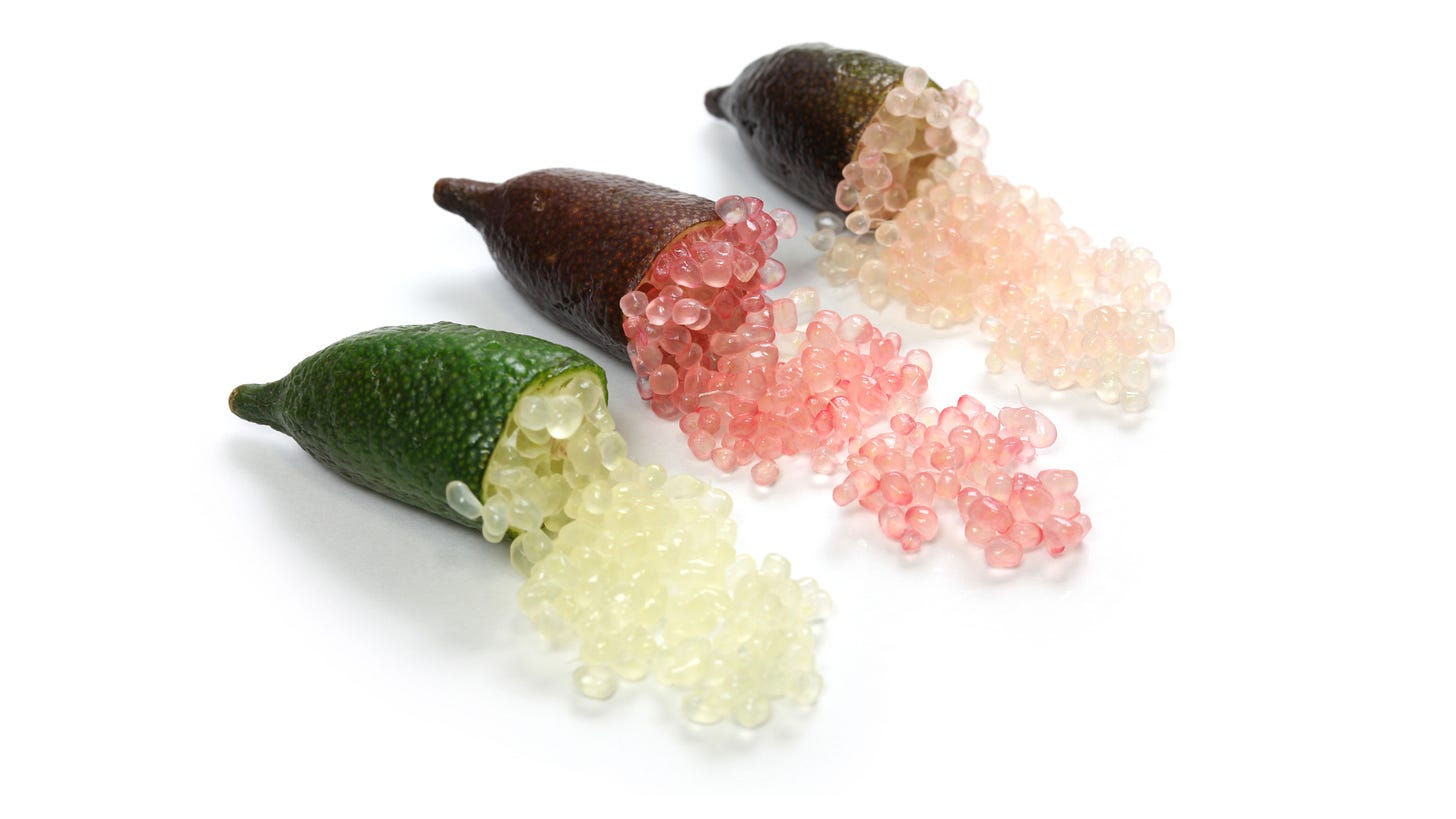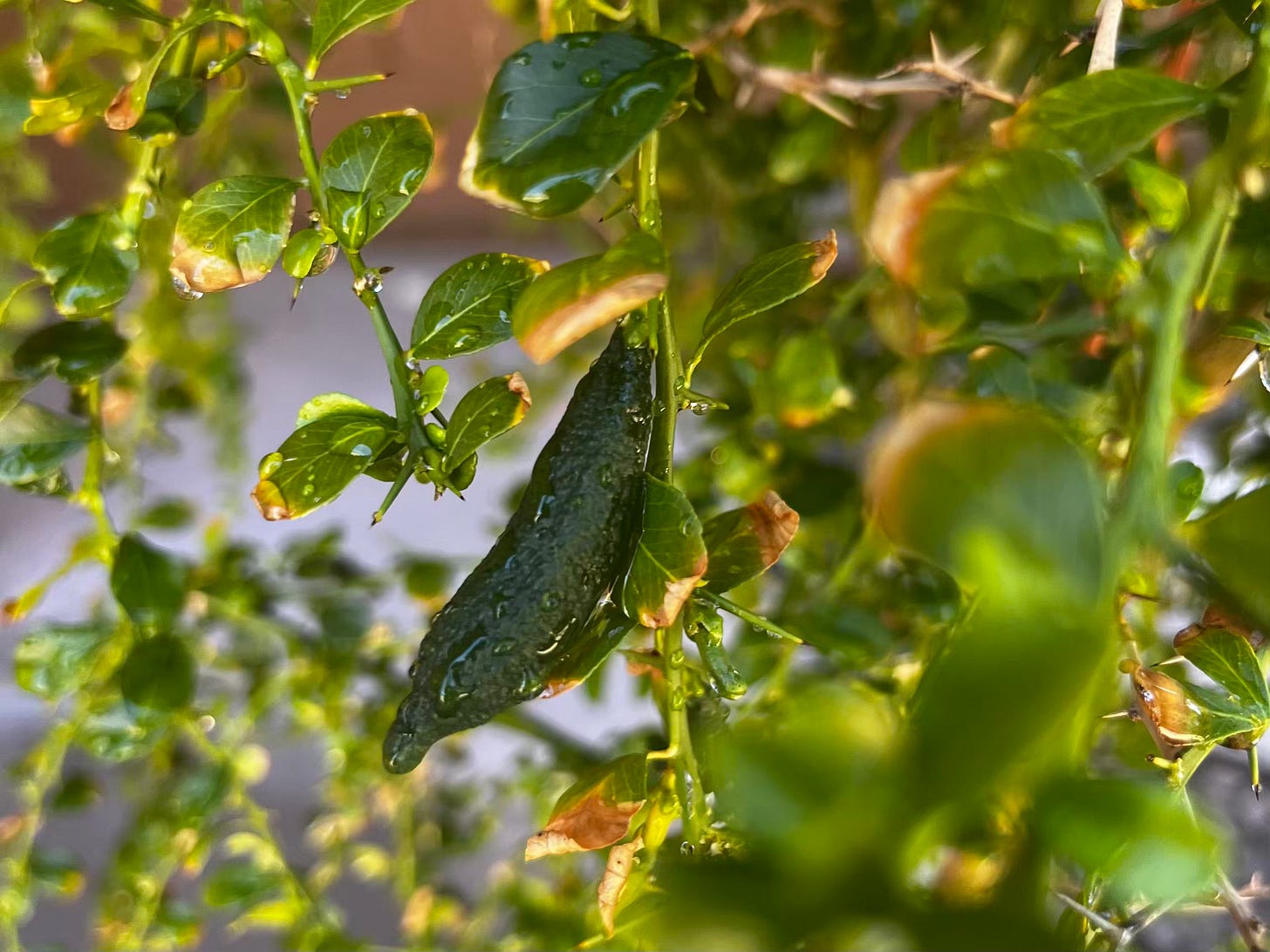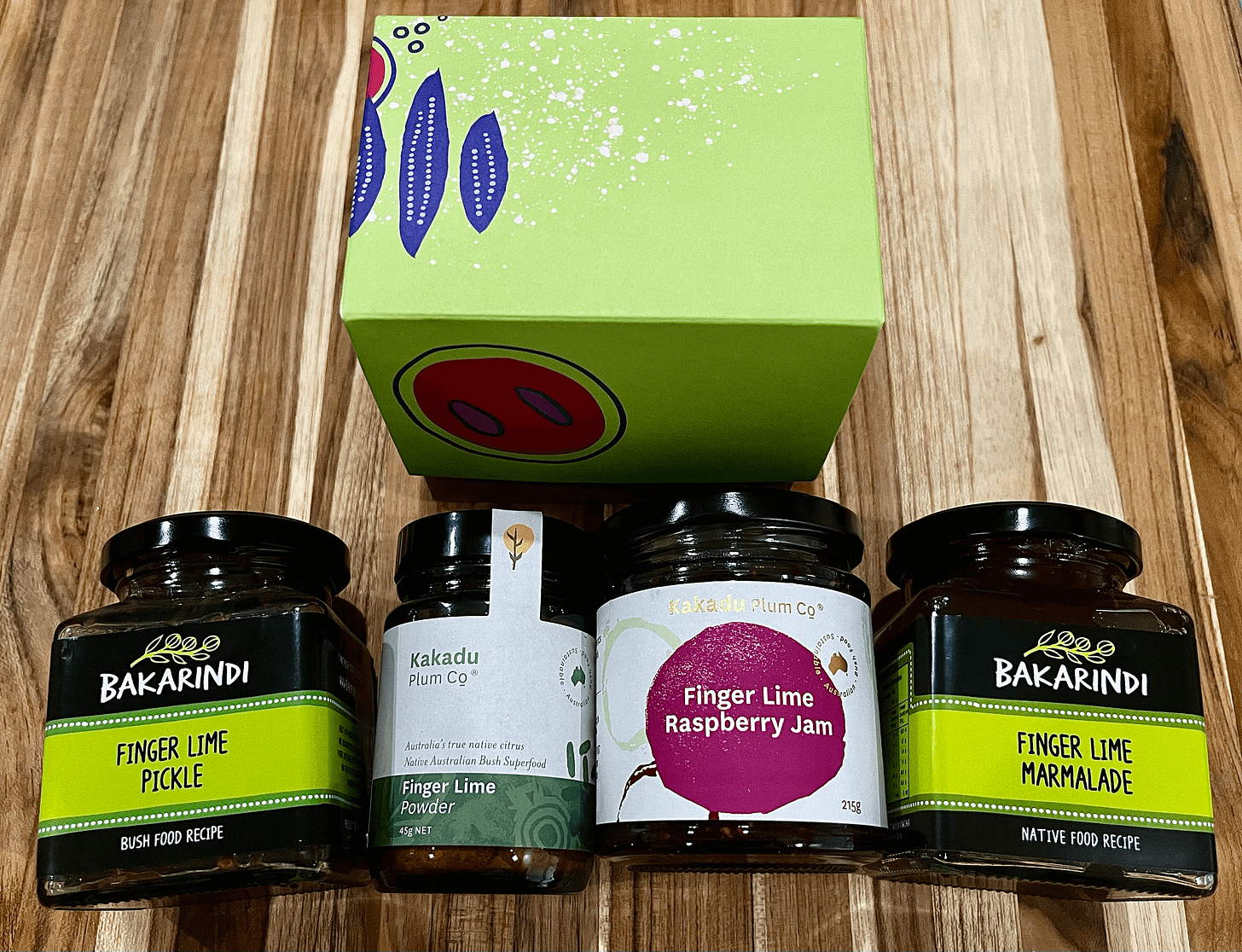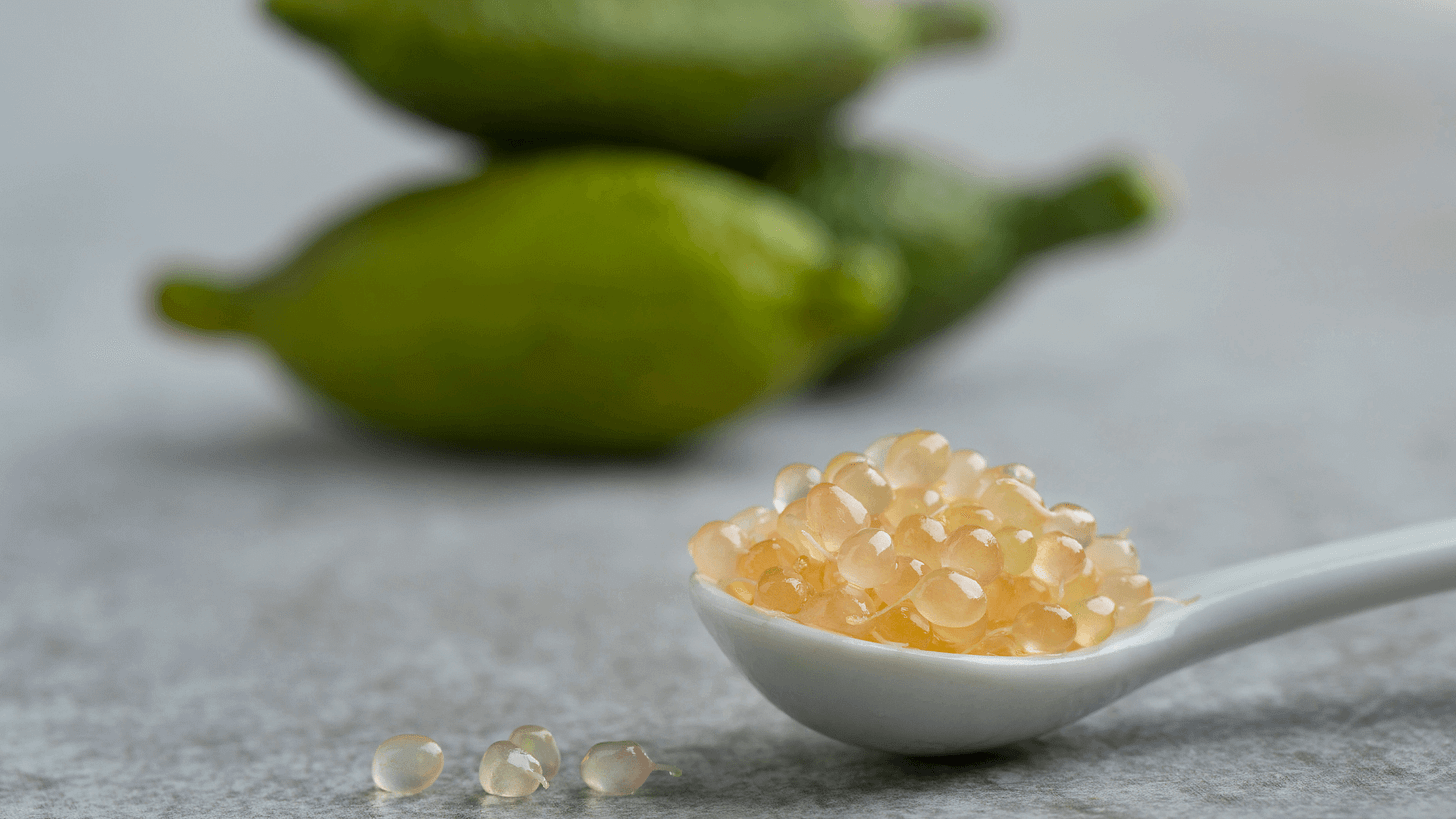I Flew Over 8000 Miles To Try This Unique Citrus - Here's Why
After watching countless episodes of Masterchef Australia, where the finger lime was often featured, I had to get my hands on the pearly citrus.
In today’s newsletter, you’ll find…
What is a finger lime? How is it different from a regular lime?
Where does it grow?
How can it be used in food?
What are possible health benefits?
Inspo for using it in your cooking
It may sound extreme to travel for citrus, but I really did become obsessed with the idea of trying a finger lime, known as plant caviar, after discovering the citrus on Masterchef Australia. I ate an entire jar of finger lime jam from Three Blue Ducks in five days. By myself. I truly cannot get over the tart sweetness and burst of citrus that the finger lime provides.
I love it so much that I found a local nursery selling Australian Finger Lime trees and now have one in a pot in my backyard.
Often called lime caviar or plant caviar in the culinary world, it’s been an ingredient that is exploding in popularity. In fact, it’s one of Australia’s most-prized bush foods thanks to a variety of colors and uses.
What is it? How is it different from a lime?
Let’s start with the shape — it legit looks like a finger instead of being a round bulb. Inside, there isn’t just flesh that you can juice or squeeze on top of a dish to add a bit of acid. Instead there are little pearls of lime juice that burst in your mouth like pop rocks. They taste acidic, a little bitter, a little bit herbaceous and earthy, a little tart.
There’s a few different colors of finger limes. A common one is the crystal finger lime with a green skin exactly the color you’d think of when you think of a lime. But then there’s pink finger limes, crimson tide finger limes with a dark brown skin, and red champagne finger limes. Each color variant has slightly different notes and levels of sweetness. If you ever come across a finger lime, I don’t recommend discriminating against color, just give it a try.
How is it used?
Honestly, the finger lime knows no bounds. It can work on top of fish to brighten the dish, it can be used on top of a dessert like a cheesecake, or you could just slather some finger lime jam on bread with some salty butter and call it a day.
You may find it as a garnish, in a jam or marmalade, in freeze-dried chips, or as a powder. Right now I’m hooked on adding finger lime powder that I’ve imported from Australia into jams. With so much good fruit this summer, I’m making small batches of jams that are more balanced with tartness and not so sweet.
Nutritional Benefits
I would be remiss if I didn’t acknowledge that the Aboriginal people of Australia have long used finger limes as both food and medicine for thousands of years. This isn’t just a fruit that’s been made popular by Three Hat or Michelin Star restaurants.
Like any citrus fruit, it’s a great source of vitamin c and flavonoids. (Author note: what the heck are flavonoids? “Flavonoids possess a number of medicinal benefits, including anticancer, antioxidant, anti-inflammatory, and antiviral properties.” - NIH)
Ok so here’s where I may go off the rails for some of you. As someone with Sjögren’s, a chronic illness, I’m always on the search for foods that can provide some sort of benefit to me beyond tasting amazing. Does that mean I only trust plant-based or natural medicine? No. I take hydroxychloroquine daily for my Sjögren’s, and very truthfully I would not be writing this newsletter if I didn’t have that medication.
But I think once you experience a chronic illness — you get a little desperate. You’re always in search of something that could potentially make you feel better, even if it’s 2% better than the day before. So I’m always open to using food as medicine. In fact,
first introduced me to the concept with her cookbooks and her autobiography, “Food Saved Me.”But back to finger limes — they have powerful antioxidants and anti-inflammatory benefits with immune-boosting properties, which are all things I’m craving as someone with an autoimmune disease. It’s also full of potassium which can help boost the nervous system too.
Now do I think a finger lime can cure my autoimmune disease? No. Not at all. And none of this is medical advice. But I do believe in the power of food on your physical and mental wellbeing. And right now, for me, a finger lime brings me an immense amount of joy. I mean, take a look at my pantry right now.
Where can it grow?
Well for starters: it grows in Australia. The finger lime is native to the rainforests of southeast Queensland and Northern New South Wales.
But if you fall in love with the idea after reading through this — you can grow a finger lime tree in USDA Hardiness Zones 8 through 11. The trees don’t like frost, but they do love the sun.
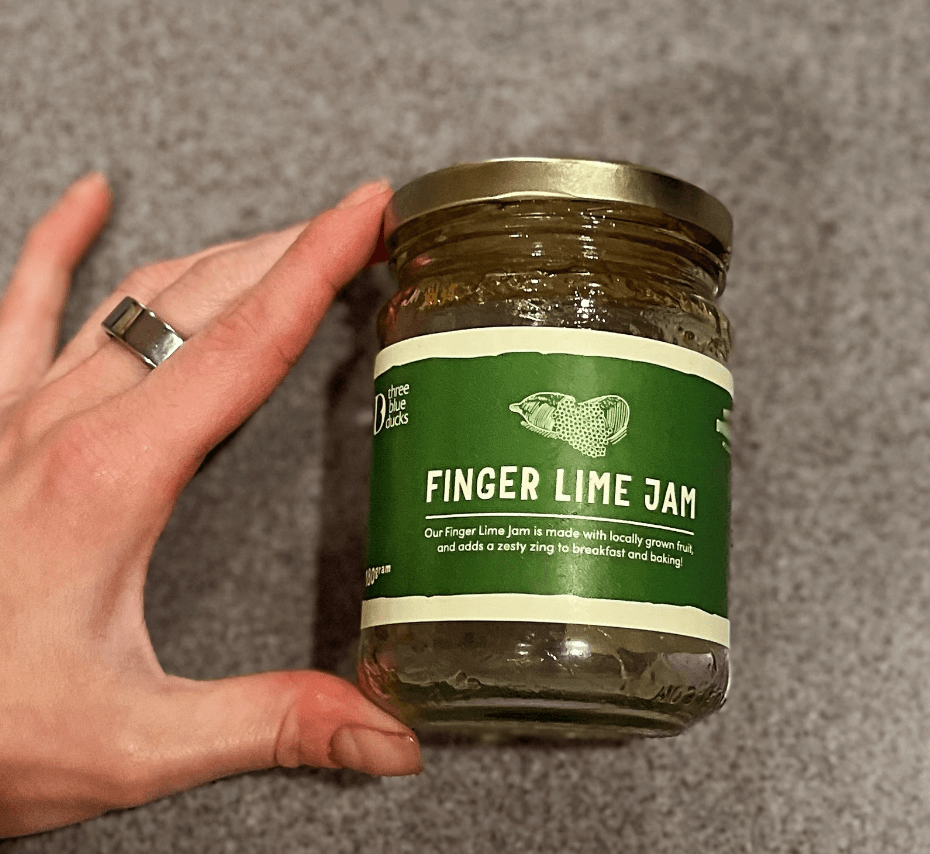
Where can I buy some?
I promise not to gatekeep — because I want you to try new foods too. So I have a few places I buy finger lime from.
But I must warn you — if you’re importing food from another country, do not expect to get your package via two-day shipping, and do not expect shipping to be cheap.
If you’re lucky enough to come across full finger limes, you can freeze them for up to 12 months.
Kakadu Plum Co. is one of my favorite online stores.
They have a wide variety of bushfoods, art, home decor, and gift ideas. I strongly encourage you to read more about them and their philosophy before purchasing, after all it’s good to know who you are supporting before purchasing.
From their ethos page:
We are not an Indigenous business. We partner and collaborate with enterprises (many that are Indigenous) that share our vision in celebrating and showcasing Indigenous products and bush foods. Kakadu Plum Co exists as a vessel to celebrate Indigenous culture everyday through food, broadening the exposure of traditional Australian bush foods and ingredients. We work directly with Traditional Owners and Indigenous Australians who wild harvest many of our foods, including Kakadu Plum and our bush tea range.
The communities and individuals we work with set the price for the foods grown on their land and we pay them directly. We believe that the more we can foster and help engage Indigenous Australians forage and engage in traditional practice and help them grow their bush food business on country, the more impact we make.
If you’re new to Australian companies who celebrate bush foods, you’ll often find notes like this:
We would like to acknowledge the Boon Wurrung people of the land on which we work and live and recognise their continuing connection to land, waters and culture. We would also like to pay respect to the Boon Wurrung Elders, past, present, and future and extend this respect to Aboriginal and Torres Strait Islander people from other communities.
I encourage you to take that in and be grateful that people are willing to share their food with you.
Warndu is another of my favorite stores for the variety of freeze-dried chips and powders they offer (and some really delicious teas which I’ll definitely write about in the future).
Warndu curates Australian Native Food Experiences. Warndu is an Indigenous owned company which means good in the Adnyamathanha language.
Be a part of the Australian native food revolution. A 60,000 year old legacy to our native plants, nuts, seeds and proteins. This is us asking questions and recognising our heritage. This is our decision to wake from past generations ignorance, to not bury our heads in the red earth, to seek healing and interconnection with people, plants and soil.
Warndu means 'good' in the Adnyamathanha language. With Warndu products we want you to feel good.
Inspo
My current creation with finger lime is a peach finger lime jam. I was on my way to a farmer’s market one Saturday morning when I drove past a U-Pick Peach Farm. After I picked up some veggies from the farm, I circled back and bought a big bag of local peaches.
Naturally I made a quick peach cobbler, but I also had to make some jam.
I don’t have an exact recipe because I truly believe everyone’s taste buds are different. I tend to prefer my jams to be less sweet. So here’s what I did:
I diced up some peaches (you don’t need pounds of fruit to make jam - small batches are more fun for experimenting), tossed in maple sugar (about a 3:1 fruit-to-sugar ratio), a few teaspoons of finger lime powder, lemon juice, and lemon rinds. I let that macerate for several hours (overnight is ideal), though I was impatient and only waited an hour or two.
After I saw a good amount of juice come out of the peaches, I started cooking the jam. Bring it up to a temperature of 220 degrees Fahrenheit (104 Celsius) and then pour it into a sterilized jar.
The combo of the sweet, though slightly tart peach, the caramel flavor of maple sugar, and the tart finger lime jam was the perfect balance with multiple layers of flavor.
I’ve been slathering this jam on The Loopy Whisk’s gluten-free english muffins. These are a must for anyone who avoids gluten. They’re pillowy soft, quick to make, and freeze well.


